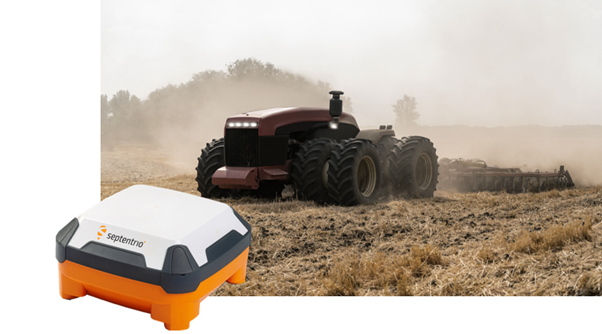Septentrio, a leader in high-precision GNSS*/INS positioning solutions, announces AntaRx-Si3. This is the first GNSS/INS (Inertial Navigation System) Smart Antenna on the market in an ultra-rugged enclosure, designed for easy installation on machines such as agriculture robots.
 This new GNSS/INS receiver uses FUSE+ technology to combine Septentrio’s renowned high-accuracy GNSS positioning with an industry-leaning IMU, in the same enclosure as the GNSS antenna. Image Credit: Septentrio
This new GNSS/INS receiver uses FUSE+ technology to combine Septentrio’s renowned high-accuracy GNSS positioning with an industry-leaning IMU, in the same enclosure as the GNSS antenna. Image Credit: Septentrio
AntaRx-Si3 is the new member of the family of receivers leveraging FUSE+, which is designed to answer the need for position availability in tough industrial environments where GNSS signal reception may be temporarily compromised, such as under foliage. The IMU sensor in FUSE+ also improves positioning integrity** and reliability, which is critical for autonomous systems.
“With AntaRx-Si3 you get a receiver delivering positioning information with a high level of availability and integrity, that you can install with minimal effort. This is especially beneficial for after-market upgrades. It also allows removal of this valuable component at the end of the day to protect against theft or vandalism,” commented Danilo Sabbatini, Product Manager of GNSS/INS at Septentrio.
The AntaRx-Si3 smart antenna is robust inside and out. It is designed to be mounted outside on a machine for operation in harsh environments out in the field. Enclosed in an impact resistant polycarbonate IP69K housing it can handle high levels of shocks and vibrations. This multi-frequency receiver delivers Septentrio’s field proven high-accuracy RTK positioning down to the centimeter level. AntaRx-Si3 has a built-in 4G cell modem, so there is no need for additional modem integration to acquire high-accuracy corrections.
AntaRx-Si3 leverages Septentrio’s GNSS+ algorithms with advanced multipath mitigation, which allows uninterrupted operation in environments where satellite signals could be reflected off nearby machinery or high structures such as silos. It delivers positioning at a high update rate and low latency, which are critical for control loops in autonomous movement or rotation. For more information about AntaRx-Si3 or other GNSS/INS solutions please contact the Septentrio team. Meet Septentrio GNSS experts at World FIRA 2024 in Toulouse, France from February 6-8.
* Global Navigation Satellite System including the American GPS, European Galileo, Russian GLONASS, Chinese BeiDou, Japan’s QZSS and India’s NavIC. These satellite constellations broadcast positioning information to receivers which use it to calculate their absolute position.
** Integrity is the measure of how truthful the positioning information really is. It gives an idea about the accuracy of the position so that one can make a judgement on how much to rely on the positioning under current conditions. For example, the current positioning may be temporarily less accurate than desired, under certain challenging conditions, such as near high structures which block GNSS satellites. Integrity information conveys the extent of accuracy degradation so the user can factor that in.